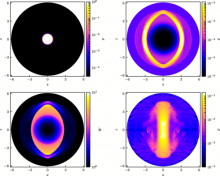
Abstract
We present SphericalNR, a new framework for the publicly available Einstein Toolkit that numerically solves the Einstein field equations coupled to the equations of general relativistic magnetohydrodynamic (GRMHD) in a 3+1 split of spacetime in spherical coordinates without symmetry assumptions. The spacetime evolution is performed using reference-metric versions of either the Baumgarte-Shapiro-Shibata-Nakamura equations or the fully covariant and conformal Z4 system with constraint damping. We have developed a reference-metric version of the Valencia formulation of GRMHD with a vector potential method, guaranteeing the absence of magnetic monopoles during the evolution. In our framework, every dynamical field (both spacetime and matter) is evolved using its components in an orthonormal basis with respect to the spherical reference metric. Furthermore, all geometric information about the spherical coordinate system is encoded in source terms appearing in the evolution equations. This allows for the straightforward extension of Cartesian high-resolution shock-capturing finite volume codes to use spherical coordinates with our framework. To this end, we have adapted GRHydro, a Cartesian finite volume GRMHD code already available in the Einstein Toolkit, to use spherical coordinates. We present the full evolution equations of the framework, as well as details of its implementation in the Einstein Toolkit. We validate SphericalNR by demonstrating it passes a variety of challenging code tests in static and dynamical spacetimes.